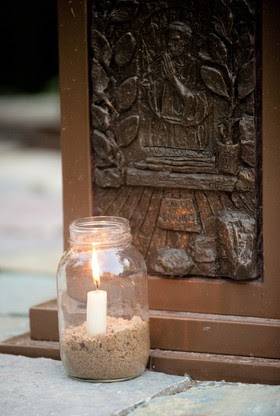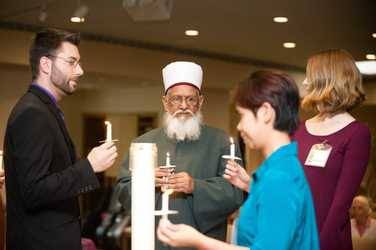Interfaith Insight - 2020
Permanent link for "Finding Resilience in Rhythm and Practice" by Kyle Kooyers on September 15, 2020
Reflecting upon the trauma, anxiety, and loss we are experiencing
here in West Michigan and around the world, I’m reminded of the words
of the legendary saxophonist, Cannonball Adderley, as he introduced a
popular blues tune written by his piano player.
Standing in a Capitol recording studio in 1966, with the band
softly grooving underneath his preacher-esque voice, Adderley
proclaims, “Ya know, sometimes we’re not prepared for adversity. When
it happens sometimes we’re caught short. We don’t know exactly how to
handle it when it comes up. Sometimes we don’t know just what to do
when adversity takes over.”
He chuckles and pauses for a moment, then continues. “And, uh, I
have advice for all of us. I got it from my pianist Joe Zawinul who
wrote this tune, and it sounds like what you’re supposed to say when
you have this type of problem… ‘Mercy, Mercy, Mercy.’”
What follows is a groovy, laid-back piece that uses a relatively
simple repeated riff, or musical phrase, to hold space for both
tension and release. This bears similarity, in both title and
function, to the Kyrie eleison, or repetition of “Lord have mercy,
Christ have mercy,” found within the Christian tradition.
People of many diverse worldview identities have these kinds of
“sacred riffs:” our words, rhythms, and practices that bring us to a
place of centering and strength – resilience – even as our adversity
is ever-present. As Adderley observes, sometime adversity - trauma,
grief, anxiety, injustice – is so great that there is no quick fix or
simple solution. It brings with it such a dysphoria or disorientation
that we are at a loss for how to respond. So we look to that which
centers us.
In her book “Trauma and Grace,” Serene Jones writes about the
power of ritual and liturgy to surprise and shape people who have
experienced immense pain and loss. She proposes the idea of “body
stories.” These are tactile or physical memories that reappear
unexpectedly in the course of a movement or practice. She draws
comparisons to yoga positions and acupuncture eliciting memory and
pain in our muscles.
Jones notes, “[They bring] to awareness areas of tightness or
pain that may have gone unnoticed or ignored for years. … To use the
language of trauma theory, the body offers up visceral testimony.”
The physical actions that we practice as people of
diverse religious, spiritual, or secular identities - the routine
passages, prayers, and ritual movements - are often what guide us as
we elicit and confront our grief and trauma. For those of us
navigating pain or loss, these repeated movements guide, re-form, and
give words to the state of our entire being at a time when we are
often incapable of doing it on our own. At the same time that these
motions invite us to enter the tension, the pain, the loss, or the
anxiety, they also remind us that we are supported and held, offering
us release.
“It is a strange, unprecedented form of embrace,” Jones observes
“The support might be an acupuncturist’s hand, a yoga teacher’s voice,
a wall you rest your legs against, or a supportive community that you
learn to lean on; it might even be a routinized prayer chant or an
internal memory of your former balance.”
For some this may look like prayer or meditation – concentrating
on the power of repeated words, chants, or breaths. For others this
may look like the tactile or embodied rhythms of passing beads through
our fingers, moving our bodies as in yoga, or returning to a familiar
text for contemplation and discernment. Often these practices can be
very commonplace, like cooking food, sewing or knitting, spending time
in nature, or going for a walk or run. All of these can welcome us
into a place of bearing witness to our own experiences and reality.
Trauma theory suggests that this witness-bearing process leads to
resilience. As Jones notes, “[B]y testifying and bearing witness, you
intuitively learn to bear up under the weight of the trauma you are speaking.”
In the midst of this global pandemic, we may be feeling
overwhelmed by the immense stress we’re under, the responsibilities of
caring for our family, of homeschooling our kids, or the looming cloud
of financial anxiety, having to navigate life now without work. We may
be struggling to keep a business afloat or navigate new realities and
rhythms around school and learning. We may feel powerless,
disheartened as we miss our routines, our favorite places, those
things we had so looked forward to, and our friends and loved ones who
are now inaccessible to us or have passed away. We may be experiencing
disparities in health care as members of communities
disproportionately affected by COVID-19, one of many layers to the
systems of injustice that already threaten the lives of BIPOC (black,
indigenous and people of color).
Trauma, grief, anxiety, and injustice abound, and there is no
quick fix or simple solution. We look to those places of centering,
space for both tension and release, to ground ourselves that we might
bear up and be resilient, ready for the next step of the healing
journey, however that may look.
For the past six years, local hospice care providers have
combined efforts to create a service for this centering and healing to
take place. We Remember: A Community Interfaith Memorial has been and
continues to be a space where the words, rhythms, and practices of
the interfaith community are offered for people to support and uphold
each other in our adversity and loss.
Using the language of many traditions - prayers, songs,
reflections, music, and readings from sacred texts – this service
gives language to grief, mourning, and celebration of life. Certainly,
as the Interfaith Memorials of years past have shown, resilience is
found within every religious, secular, and spiritual identity.
This year’s Community Interfaith Memorial Service will be
held virtually at 6:30 p.m. on Tuesday, Sept. 15. Participants will
have the opportunity to process the forms of loss experienced during
the COVID-19 pandemic. The theme of this year’s service will be resilience.
The annual event will offer a 45-minute memorial service,
streamed on Facebook and YouTube, followed by a 45-minute live
discussion group via Zoom. The service will feature music, reflection,
prayer and poetry from various traditions. The live discussion will
offer large group and chat-room style spaces to virtually connect with
others under the facilitation of bereavement counselors.
Whether grieving recent losses, honoring those who have long
since passed, or simply curious as to how various traditions
commemorate the passing of life, all are welcome to share in this
family-friendly space.
May we continually enter the brave work, embodied by
the Interfaith Memorial, of seeking healing through community with one
another, even while virtual and socially distanced, for this unique
season of adversity and loss. Through togetherness and solidarity,
centered in hope by those “sacred riffs,” our collective song of
resilience is born.
Posted on Permanent link for "Finding Resilience in Rhythm and Practice" by Kyle Kooyers on September 15, 2020.



